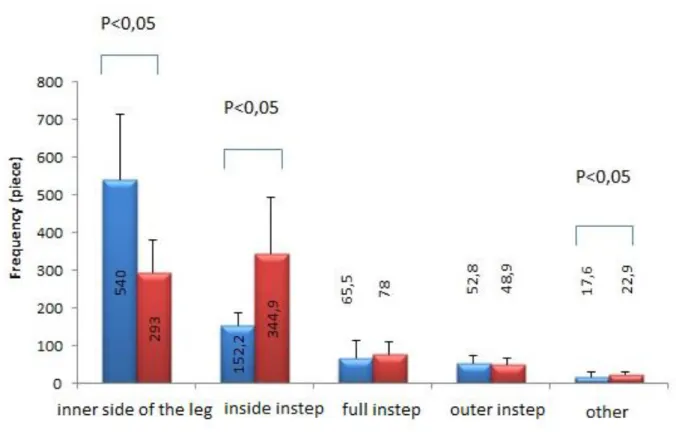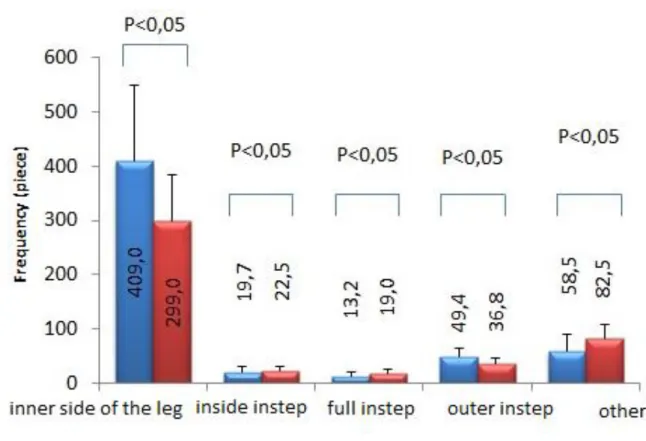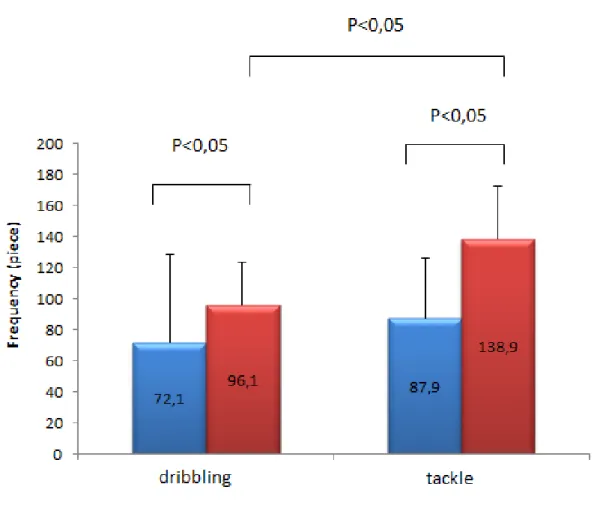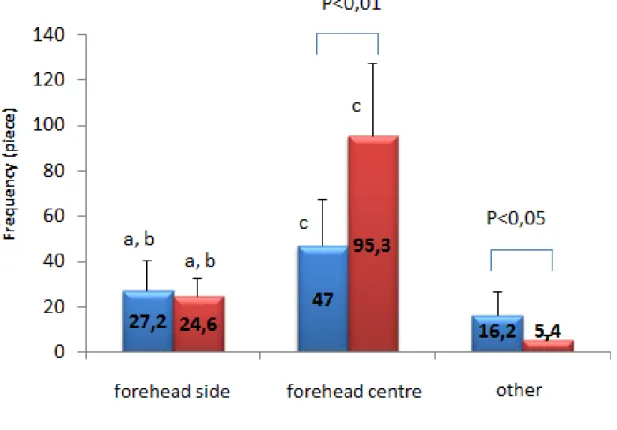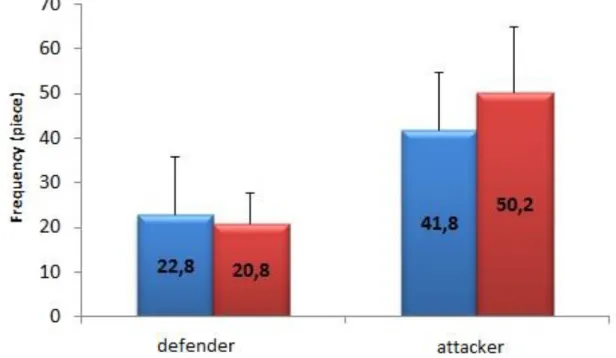Comparative analysis of technical elements displayed at football matches at the Hungarian and the international
level
Abstract of PhD thesis
János Tóth jr.
Doctoral School of Sport Sciences, University of Physical Education
Supervisor: Dr. Pál Hamar professor, PhD
Official Reviewers: Dr. Tamás Szabó professor, CSc
Dr. Trzaskoma Łukasz expert advisor, PhD
Head of the Examination Committee:
Prof. Dr. Csaba Istvánfi professor emeritus, CSc Members of the Final Examination Committee:
Prof. Dr. Zsolt Radák professor, DSc Dr. László Bárdos associate professor, PhD
Budapest
2017
1 1. INTRODUCTION
Nowadays, in our dynamically improving world, numerous new ideas, plans and concepts have evolved that may very well facilitate changes in the quality of our lives. Such developments and research are traceable in any area of life, work or professional field, among these, in the field of sports. Modern equipment, new training methods and complementing procedures have been developed and through these we can achieve an increase in performance. Nevertheless, not all such tendencies take notice of the different effects concomitant of individuals’ (competitor, player, coach etc.) improvement in performance.
There are also pedagogical and psychological effects which do not necessarily correspond with the performance-centred views.
In light of the extensive criticism of football, one might wonder what makes our branch of sport different from those of other nations’, in what way do they know more or perform better than does Hungary. That is a rather complicated question. To begin with, one can mention infrastructure, equipment, material and financial conditions, selection and training system (both in regard of players and coaches), personnel, mentality and attitude. As long as the budget of an international club exceeds that of the whole Hungarian first division, it would be futile to pretend they are comparable or attempt to make a valid comparison of the Hungarian and international standards. While other nations have been able draw on the available conditions (facilities, fields) for decades, we began to establish such conditions only a few years ago. For example, the team of Ajax Amsterdam already had a covered, so-called artificial turf facility in the late 1980s while in Hungary, the first high-side artificial turf pitches were opened in 1998 in Népliget. Nowadays, artificial turf pitches have become less favoured internationally as they might present a potential health risk to young people in the long therm. Meanwhile in Hungary, we are intent on building as many as possible (which, all in all, might be considered an achievement, as we are in shortage of pitches altogether).
Unfortunately the reason for the preference of artificial turf in Hungary is that they are - falsely - believed to implicate lower costs in the long term as they require no cutting, tending to or watering. It has been recently found that the life span of such pitches can be extended and their health-hazarding effects reduced if they are tended to by special machines and for hygienic reasons, they require watering. The high-sounding expansion of our Academy system also looks promising. Its classical form was introduced by the French in the 1980s and later abandoned following the turn of the millennium down to various sociological implications (the live-in system was replaced by placement of students with their families).
Meanwhile, we continuously attempt to establish the obsolete classical systems (true, this is still better than having nothing at all). On the recommendation of UEFA, this sport is making
2
an effort to produce its organic and operating parts that is, coaches and managers. It is a rather delicate issue based on the events from the 1990s onwards. Coaching and other personnel grades which take years in England may be attained in Hungary in monthly scheduling but in terms of the number of hours, perhaps they are better (but still not appropriately) applied nowadays. Considering the above factors, the question arises whether we should only find fault with our players (who are so maliciously criticised by the public). It is not their fault that they have been trained in this system and such external factors have influenced their development. The foundation of our football should be laid by a planned and systematic junior training system. It is important to mention futsal (a base game in Brazil) as an unexploited area in the education process, which may lay the groundwork for younger age groups in the process of preparation for later, playing on bigger and bigger sized football pitch. Order, discipline and organisation comprise the pillars of reliance on each other. Until we have laid the groundwork, no long-term ambitions can be fulfilled.
My view is that there exist such factors that can be mapped through countries (having more extensive football culture than Hungary) to our scale. It is worthy of consideration that unless we attain a sufficient technical level we shall not be able to properly exploit our physical conditions, moreover, we shall not be able to implement tactical tasks. Of course, these components are correlating as it is inevitable to attain certain physical condition in order to be able to implement particular tactical tasks. Research has been carried out on technique however, this area has not comprised the prime focus of such research into the sport. This is the reason, among others, why I have chosen this area.
2. OBJECTIVES
During my work, I have sought to analyse such areas wherein the consequences drawn might provide assistance to the improvement of Hungarian football. I need to find the conditions that are given for all. Among others, performance on the pitch where they culminate, which presents the end-product of education and training. If we take a Hungarian and an international football match, we shall find a number of differences. Such differences are displayed in the area of techniques, tactics and condition. These areas correlate with each other, they influence their own quality and quantity. A difference in the speed of the game and the players can often be detected. In my view, this differences is also present on all three areas but I think the most important element of the three pillars is technique.
In this paper, I intend to analyse technique through the examination of the technical elements appearing during games. Then, based on the results, wish to make propositions for the development potentials and tendencies, also the possibilities of education. Based on the
3
research findings I intend to identify areas that need more emphasis than they were previously paid in the course of education (I shall deal with the education methodology in a separate chapter). Furthermore, to provide an insight into the various football cultures' style features as nowadays the style of various nations are not as easily identifiable as they were decades ago owing to the fact that the free movement of persons has brought about an increase in the number of foreign players. Can the much discussed English style or the so-called imported Spanish style (introduced by Johan Cruijiff from the Neatherlands) be easily differentiated? I intend to implement/elaborate on the questions arising as well as on the set of issues previously brought up through hypotheses.
Hypotheses:
1. The amount of ball technique (player is running with the ball, instead of passing it over to a mate) is higher during Hungarian games than at international games.
2. The controlling of the ball during Hungarian games show a higher proportion to those at international matches.
3. At international games, the outer instep activity (ball technique, controlling the ball, running with the ball) show a higher proportion compared to that of the Hungarian numbers.
4. Dribbling and tackling appear in higher number during Hungarian matches.
I am introducing the underlying techniques from various approaches in detail in a separate chapter.
3. MATERIAL AND TOOLS
3.1. Introduction of research sample and methods applied
I conducted this research of the above introduced technical elements set in a system, as it was earlier concluded that one particular technical element may be categorised in various ways.
During the respective matches, I was observing the appearance form, frequency and significance of these. I was using video analysis and various tools and methods for this research.
The advantages and disadvantages of this method are clearly identifiable. An advantage to live analysis - among others - is that a recording may be paused and rewound allowing thorough examination. A challenge during assessment is that during the replays showing coaches and spectators, live picture cannot be fully monitored. To fine-tune the examination, it is recommended to create various special software for future analyses.
One of the tools I was using was a DVD/VHS Recorder that, apart from the traditional VHS recording function also has a DVD writing function and was able to record.) It proved to
4
be an asset. Firstly, the amount of recordings was not limited due to the rewritable DVD and secondly, also an important factor is that, during recording the quality did not deteriorate as the quality of recording could be set on the equipment. Each time I recorded television programmes, my preference was to HD channels and recordings. It played a vital role as for instance in many cases, it allowed easier evaluation of a particular kick type or of the surface.
On several occasions, where it was not possible to judge the surface, the movement of the ball enabled me to make accurate guesses as to the type of kick. On several occasions the replays confirmed or gave clear picture of the activity. The recordings did not always followed the ball movements (coaches, spectators, managers, players were shown instead). In such cases it was possible to deduce the eventual missing scenes from the movement of the ball or the players, their positions and the set passing around. In my view, they were well within the 5 per cent error margin. I made recordings from the programmes of M1, DUNATV, SPORT1, SPORT2, DIGISPORT1 and DIGISPORT2.
In addition, the Internet provided significant assistance as numerous matches can be viewed live or recording or can even be downloaded from various pages and surfaces. That enabled me to further expand my data base. Such web pages include http://www.fullmatches.net, http://livefootballvideo.com, and matchcenter program that can be found at mlsz.hu. I conducted sporadic sampling for convenience.
All analysed matches took place during the period from 2009 to 2013. Following the recordings, as a next phase of collecting data, I began to analyse particular games as it was not possible to take notes and monitor the events simultaneously during a live programme.
The analysis of the first game required four hours. Later, drawing on the experience and due to practice, this amount of time was reduced below 180 minutes. An example is a computer analysis during which the video player was set to play at 0.5 x speed that allowed me to document all important events during the games. The data were recorded on spreadsheets designed for this purpose. Then these sheets were entered into Microsoft Excel program in special spreadsheets where the basic statistical calculations could be carried out (summing, average and dispersion, minimum, maximum). Later on, as the amount of data was increasing, I arranged the data and tables in various categories by nation. And thus the categories of Hungarian and international matches were determined. Then I further categorized the international matches based on the nationality of clubs. During data collection, the assistance of Csaba Gál was invaluable, whose data obtained during his research I also made use of (Gál 2012.). To increase the volume of data and improve the value of the work, I am contrasting the Hungarian and international matches assessed by Bacsó, Göltl, Tóth and Pari in 1989 and
5
1999 with the matches I analysed during the period from 2009 and 2013. This means, that the research is taking up 25 years period, which I dare say, can be deemed unique in its kind.
3.2. Statistical analysis
I was using core statistics for the characterisation of samples during calculations, so I determined the average and dispersion of variables. As the examined data are whole numbers, I used nonparametric Mann-Whitney U Test for showing the differentials. I applied Spearman's rank correlation for showing the correlations between the variables. I carried out the calculations with the assistance of Statistica 10.10 (Statsoft. Incl) program. In the tables and graphs, I marked significant differences belonging to the range of <0.05 with an asterisk.
4. RESULTS
4.1. Results of running with the ball
I divided running with the ball in three categories according to the surfaces touching the ball:
inside instep, full instep and outer instep (see Figure 1.)
Figure 1.: Result of running with the ball, frequency of mean and standard deviation of the international (blue columns) and hungarian (red column) matches.
From the aspect of implementing basic techniques, that is, running with the ball using instep, higher values are displayed at Hungarian matches. Unlike in international play, the dispersion rate is is significantly lower. Full instep, though slightly, seems higher at
6
international matches further, the amount of outer instep is significantly lower in international play. Statistically significantly difference between the values cannot be shown. The vast majority of running with the ball is performed with inside or outer instep, full instep is less significant during a football match. A possible reason is that more efficient ball covering may be carried out more successfully using inside or outer instep.
4.2 Results of passing and kick
I divided this technical element into five major areas. Inner side of the leg, inside instep, full instep, outer instep, further other surfaces, solutions (sole, calf, breast, shoulder) (Figure 2.)
Figure 2.: Result of passing and kicking, frequency of mean and standard deviation of the international (blue columns) and hungarian (red column) matches.
The amount of passing of the ball and kicks in case of the inner part of the leg is significantly higher at the international matches while the outer instep displays higher values at Hungarian matches. Full instep and other techniques are more frequently displayed at Hungarian matches while outer instep is more frequent at international matches. Based on statistical calculations, inside, inside kick and other passings and kicks display significant differences. The frequency of passings and kicks is the highest among inside and instep kicks.
The proportion of other surfaces is lower.
7 4.3. Results of controlling/receiving the ball
I categorised controlling the ball in the manner as passing and kicks, in identical form. (Figure 3.)
Figure 3.: Result of receiving the ball, frequency of mean and standard deviation of the international (blue columns) and hungarian (red column) matches.
Controlling the ball with the inner side of the leg displays higher value at international matches, however, the same applies only to outer instep. Inside instep, full instep and other techniques are more frequently displayed at Hungarian matches. The nonparametric two- sample T test displayed significant differences in both cases. In case of controlling the ball, it is clearly shown that the most frequent type is controlling the ball with the inner side of the leg then follows falling by far below, outer instep and other forms of controlling the ball.
8 4.4. Results of dribbling and tackle
I intend to introduce these two technical elements in a sub-chapter to provide a graphic insight, further I am trustful that these will have a significant impact on each other.
Figure 4.: Result of dribbling and tackle, frequency of mean and standard deviation of the international (blue columns) and hungarian (red column) matches.
The table clearly shows that the amount of dribbling is higher at Hungarian matches.
One possible reason is that individual initiative is applied more frequently albeit the collective game.
Similarly to dribbling, tackling occurs more frequently at Hungarian matches. (Figure 4.) In both cases, there are significant differences in favour of Hungarian matches. Dribbling is always displayed at higher number further it must be emphasised that it invariably occurs in a higher number at Hungarian matches. The reason for this may be inferred from the above mentioned events as higher amount of dribbling may generate an increase in the number of tackling. Further, taking over the ball may not only be resulted from 1:1 situations but also from confusing concerted team play.
9 4.5. Results of headings
I divided headings into three major categories (Figure 5.). Heading the ball with the side, centre and other types (e.g.passing on by a slight touch of the head)
Figure 5.: Result of heading, frequency of mean and standard deviation of the international (blue columns) and hungarian (red column) matches.
Heading using the side of forehead shows minimal difference in favour of international matches while the centre of the forehead is more frequently applied at Hungarian matches. Other techniques are displayed more frequently at international matches. Significant difference can be found in case of centre forehead and other techniques. Heading using the centre of the forehead occurs far more frequently at football matches as opposed to the side or any other type of heading. Heading using the centre of the forehead were displayed more frequently at Hungarian matches while all other types were displayed more frequently at international matches.
10 4.6. Results of throw-ins
During the research, the throw-ins derived the least complicated situations.
Figure 6.: Result of throw-ins, frequency of mean and standard deviation of the international (blue columns) and hungarian (red column) matches.
In case of throw-ins negligible difference was displayed in favour of international matches. That is, there was no significant difference. The slightest difference is shown for throw-ins, that is, less than two decimals, which is negligible as far as the comparison is concerned.
11 4.7. Results of goalkeeper techniques
I have categorised goalkeeper techniques according to the mentioned defender and attacker aspects. (Figure 7.)
Figure 7.: Result of goalkeeper techniques, frequency of mean and standard deviation of the international (blue columns) and hungarian (red column) matches.
It is interesting to find that there tend to be more defender type activities at international games, while at the Hungarian ones, there are more attacker type activities.
Neither the defender nor the attacker type shows significant difference. It is important to note that in contemporary football, a goalkeeper tends to have an increased attacker role/situations during a match than defender. All in all, at international matches, the emphasis tends to shift towards the defensive role, while during Hungarian matches, on the attacker role.
12 5. CONCLUSIONS
It can be clearly concluded that at the international level, the number of technical elements displayed is, in comparison to the Hungarian level, higher and this result’s average can be traced back to the 1989. Based on the results presented, my hypotheses were, in certain cases, only partly supported.
My first hypothesis focusing on running with the ball, in particular, stating that frequency at Hungarian matches are higher was not supported as I have found no significant difference between international and Hungarian matches. Based on the compared values, international matches show a greater rate that is, 325,54 compared to the Hungarian 261,87.
My second hypothesis, shifting the emphasis to controlling the ball, had to be discarded too as it was not supported. Invariably, I found significant difference in respect of the various forms of controlling the ball. However, in respect of controlling the ball with inside instep and outer instep, they occurred more frequently during Hungarian matches.
Altogether, there were 549,83 occurrences at international matches while 459,82 at Hungarian ones.
My third hypothesis was only partly supported as the activity performed using the outer instep (running with the ball, passing, controlling the ball) invariably showed a higher amount compared with the Hungarian matches but significant differences were only found in case of controlling the ball.
My fourth hypothesis was supported as dribbling and tackle were displayed at higher a number at Hungarian matches; and in both cases, significant difference was shown.
The findings allow us to draw conclusions as to the technical activity performed at a football match. Contrasting international and Hungarian matches, it can be asserted that the activities displayed on the pitch, partly, show difference in number. Slighter differences can be found invariably, but the most highlighted area is the use of outer instep. In this regard, there is a significant difference. In case of running with the ball and passing and controlling the ball there is a slighter difference, but all in all, it can be asserted that it has an important role during the matches. If these elements are more frequently used by the international top leagues, it is worthy of contemplating that in terms of education, these areas might need to be given more emphasis through the education exercises/aspects to be introduced in a separate chapter so that we could catch up to the extent possible with the international league.
13 SUMMARY
Technical elements are significant factors influencing a football game. One technical element may be categorised in several ways or may be disseminated into several components so they are taught and practised according to various aspects. In the outcomes of Hungarian and international matches, the implementation of various technical elements are shown as influencing factors. The rate of their average display is different in the Hungarian and international to league. Some of the technical elements occur more frequent at Hungarian, while other elements occur more frequently during international games. Significant difference is displayed in case of running with the ball: it was more frequently implemented with inside kick at international matches (144,4±124,15) compared to the Hungarian average (74,13±27,024). I have found similarity in the passing of the ball using the inside of the foot where the international number was 540±174 contrasted with the Hungarian 293±89 value. A huge difference is shown in case of inside instep in favour of the Hungarian matches (344,87±149,05) compared with the international 152,2±33,7 value. Similarly to controlling the ball, impressive difference is shown by the use of the inside of the foot (409±139) and 299±82,3) at international and at Hungarian level, respectively. Dribbling and tackling is more frequent on the Hungarian side, tackling showing the larger difference. Heading with the centre of the forehead, based on numerical data shows significant difference (95,3±31,753). In case of throw-ins, there was no notable difference while goalkeeper technique tends to be slightly more defensive at an international level and slightly more offensive during Hungarian play. Apart from that, I found significant difference only in case of passing the ball, using the inside of the foot or inside instep kicks and other techniques.
This means p<0,05, in each case of passing the ball and the same applies to tackling.
Significant differences other than the aforementioned were found only in case of heading using the central part of the forehead and other heading techniques. These finding partly support the correlation between the particular technical elements. Consequently the findings might point out in which direction the emphasis of the training process should be shifted to so that Hungarian football could be able to come up and reach that of the international top leagues’ level.
14 LIST OF AUTHOR'S PUBLICATIONS
1. Tóth J, ifj. Tóth J. (2010) Labdarúgást előkészítő játékok általános iskolás gyerekek részére. Futball, 23: 10-12.
2. Tóth J, ifj. Tóth J. (2010) Átadás-átvétel gyakorlatok általános iskolás gyerekek részére. Futball, 24: 10-12.
3. Tóth J, ifj. Tóth J. (2010) Cselezés-szerelés oktatása általános iskolai keretek között.
Futball, 25: 16-19.
4. Tóth J, ifj. Tóth J. (2010) A fejelés oktatása és játékai az általános iskola alsó tagozatában. Futball, 26: 16-19.
5. Tóth J, ifj. Tóth J. (2010) A fejelés oktatása és játékai az általános iskola felső tagozatában és a középiskolában. Futball, 27: 16-19.
6. Tóth J, ifj. Tóth J. (2010) Taktikai alapok az együttes támadójátékban. Futball, 28:
16-19.
7. ifj. Tóth J, Tóth J, Hamar P. (2011) Egyetemi hallgatók labdarúgótudásának fejlődési tendenciái a TF-en eltöltött évek során. Kalokagathia, 2010. 4. – 2011. 1: 57-68.
8. Tóth J, ifj. Tóth J. Az utánpótláskorú labdarúgók felkészítésének szakmai követelményei. Magánkiadás, Budapest, 2011.
9. ifj. Tóth J, Csáki I, Tóth J. (2012) The examination of the 4:4 game at diamond and square. Edu Art Gym, 1: 89-99.
10. ifj. Tóth J, Tóth J, Hamar P. (2012) Iskolai testnevelésben és tanórán kívüli labdarúgó foglalkozásokon részt vevő 9-10 éves tanulók teljesítményének elemzése. Magyar Sporttudományi Szemle, 13. 49: 41-45.
11. ifj. Tóth J, Zalai D, Tóth J, Hamar P. (2013) The 3 vs 1 game build-up effectiveness examination in physical and technical tests of 11-year-old football players. Biomed Hum Kinet, 5(1): 108–112.
12. Tóth J, ifj. Tóth J. Az utánpótláskorú labdarúgók felkészítésének szakmai követelményei. Magánkiadás, Budapest, 2016.

